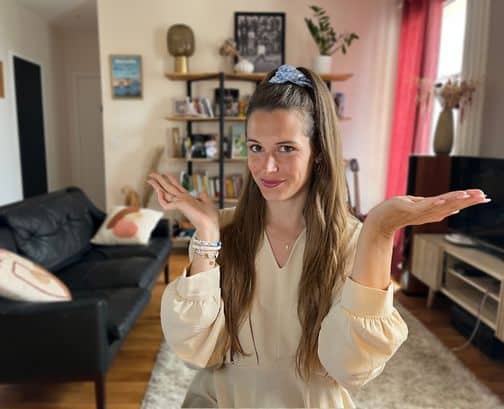Transcription
I'm sure you're like me and like to taste the local specialities when you're on vacation.
But when the menu is not in our language, it can quickly take 20 minutes to read the entire restaurant menu. I'm sure you know this as well as I do.
You try to quickly look up all the Google translations of words on your phone, and you're stressed that the waitress or waiter will come back before you've had a chance to understand everything. But I don't want that to happen to you in France.
Today, I'd like to invite you to read a menu together. Together, we're going to read the menu of a restaurant, including starters, main courses and desserts.
As usual, you can download the video's vocabulary sheet by clicking on the link in the description.
I chose a very popular restaurant in the center of Paris. It's a bouillon. A bouillon is a type of restaurant that offers traditional food and is generally inexpensive.
So, let's start with the starters on this menu. You can see, for €2.50, you can have eggs mayonnaise. When we say eggs mayonnaise, in France, we mean hard-boiled eggs.
We cook the eggs for about 10 minutes. And we'll put mayonnaise on top.
The menu also includes eggs meurette.
This is a preparation in which eggs are poached. It's a way of cooking eggs where they remain runny inside, where the yolk flows. Eggs meurette are served with a sauce called meurette. It's a rather rich, heavy sauce, based on red wine.
Duck terrine with green pepper. Terrine is a kind of pâté.
In this case, it's a meat-based preparation, but it can also be made with fish or vegetables in a generally rectangular dish and served cold. It's not hot, it's served cold.
The duck is an animal, it's this.
There's green pepper, a kind of pepper.
Frisée salad with chicken gizzards confit.
A frisée salad is a type of salad, a variety of salad. In France, it's very popular in this type of restaurant to have gizzard salads. In reality, the gizzard is a part of the stomach found in poultry, for example, in hens and turkeys...
Here, they're called confit, meaning they've been preserved in fat. It's a preservation method.
There's a bunch of shrimp. The shrimp, of course, on the screen, is this. You may know the word. Why do we say bouquet? Because it's the way they're arranged on the plate, like a bouquet of flowers. They're nicely arranged.
You see, we also have leek vinaigrette. This is a classic French bistro starter. Leeks are this vegetable and we have a vinaigrette. It's a mixture of oil, vinegar and seasoning.
In the menu, you can see that there is both a bouillon and a velouté. On menus in France, you'll also see the word soupe or potage.
Let me explain the difference, because it can be a bit confusing. A soup is pretty much the same thing.
It's the generic word for a liquid dish based on vegetables, meat or fish. The texture of the soup can vary.
It can be more or less liquid.
When we talk about a velouté, it's creamier, smoother and smoother. In general, there are no chunks, often because cream is added.
In the velouté, you can see that there's cauliflower - it's this, this vegetable - and slivers of chestnuts. They're called chips because they're small pieces.
Here we see a velouté with ceps. Ceps are a kind of mushroom.
A broth, on the other hand, is a much lighter soup. You can usually see through it. It's much clearer, much more liquid, less thick.
The vegetables or meat will be used to add flavour, but they are not mixed with the water. In short, we eat cooking water.
You see, the chicken broth has vermicelli in it. Vermicelli is a kind of very fine paste. I'll show you what it is. It's often used in broths to add a little extra substance.
Snails with parsley butter. If you're interested in French gastronomy, you're bound to have heard of snails. And we're talking about beurre persillé, because we're going to put parsley in the butter.
We'll mix the butter with parsley. It gives it a grassy taste.
Oysters, of course, are another classic of French gastronomy.
And finally, it says medaillon de bloc de foie gras. A medallion, again, is a bit like the bouquet, it's just the way it's presented.
A medallion can also be this, you see. And here, it's the same thing. It can be a medallion of foie gras, but also a medallion of beef or veal. It simply means that the meat or product is presented in a round or oval shape.
Before we move on to the dish, I know that you're passionate about food, and if you're here, especially French food. I understand why from a gastronomic point of view, but also from a learning point of view, because it's a great way to learn new vocabulary, to get interested in food.
By the way, today is Wednesday and it's my favorite day of the week because I'm posting the video, but also because there's a show on TV called Top Chef.
It's a cooking competition for chefs. I tell you this a lot, but watching authentic content is a great way to practice your French in a gentle and enjoyable way, without really feeling like you're working.
But I know that this type of program is not always available in your country. So I'm delighted to renew my partnership with NordVPN.
This is the video sponsor. I'm going to take a minute to tell you all about it. I'm sure you're already familiar with the NordVPN system, but if you're not, listen up because it may be of interest to you who are learning French. A VPN is a tool that allows you to change the geographical location of your computer, tablet or phone.
This allows you to access content that would normally be blocked in your country, in your geographical area.
With a VPN, you'll be able to watch authentic content on the sites of French TV channels, including cooking programs if you're passionate about gastronomy, the news if you prefer to talk about current affairs, and French TV series.
If you want to try NordVPN, you don't have to take many risks because you're offered 30 days. And thanks to the link I put in the video description, you have a two-year plan with four months free.
So don't hesitate to take advantage.
Let's move on to the main courses. We can see that there's onion soup au gratin with Cantal. Cantal is a type of hard cheese. Cantal, by the way, is a region of France, and it's a cheese that comes from that region, of course.
The onion, of course, is this. You see, here we have the word soup, as I was explaining before when we were talking about starters. When you have a soup au gratin, it means there's cheese on top, so the soup has been in the oven.
Sausage with a knife, mashed potatoes. Mashed potatoes are usually mashed potatoes, but they can also be mashed vegetables. And a knife-edged sausage is this piece of meat. And we specify "au couteau", which means it's not industrial. The meat has been prepared with a knife, so it's quite artisanal.
Tartiflette with Reblochon. Reblochon, once again, is a kind of cheese with a very strong smell. And tartiflette, if you've never had it before, you absolutely must try it if you come to France.
It's a dish that's best served in winter and in places where it's cold, such as the mountains. But you can make it yourself, or try it in other restaurants.
It's a dish based on potatoes, onions and lardons. Lardons are small pieces of pork fat. And you have the famous Reblochon cheese on top. It's a kind of gratin.
You can see that there are also ravioles du Dauphiné with leek fondue. Ravioles are a type of ravioli. You're probably familiar with Italian ravioli.
It's a bit similar. And from the Dauphiné region of France, where this pasta originated. Next, a leek fondue. Leeks are this vegetable.
And when we say "fondue", we mean the preparation. Don't expect it to be a fondue like a fondue bourguignonne or a cheese fondue.
It's more a case of letting the leeks cook long enough for them to melt. You don't really have to chew them anymore. They're finely chopped and then slowly cooked in butter.
We see a cabbage stuffed with vegetables. A cabbage is this vegetable. With mushrooms and lentils. I'll show you the pictures.
Skate with capers, lemons, croutons and steamed potatoes. Skate is a very flat fish. It's often eaten with capers.
Croutons are small pieces of bread that are crispy. They are cut into cubes. They are usually grilled or roasted.
We often put them in soups or salads to add a little crunchy texture.
And here, be careful, because it says steamed apple, so you might think it's the fruit, but it's actually potatoes. I think they've put this heading because it's obvious from the dish that it's potatoes. And steam means no fat. So it's steamed.
Then we have the quarter chicken, chicken sauce with fries. So, chicken is chicken. It's the meat that comes from the "chicken" animal.
It's called poulette sauce because it tastes a bit like poultry, like chicken.
And in it, I think there are also mushrooms, egg, there are a few other ingredients, but it tastes overall of poultry. The fries, of course, the French fries.
We see half a shank caramelized again with French fries.
The hock is a piece of meat. It's the part behind the knee of a pig. But when we talk about meat, we're going to say pork. You can read that the shank, this piece of meat, is caramelized. When we caramelize a meat, it's a new cooking technique where the meat is really browned. The skin is colored and crispy.
Boeuf bourguignon with smoked bacon and coquillettes. Is it still necessary to introduce boeuf bourguignon? It's a preparation, a dish of meat in a sauce with wine.
These are pieces of beef. There are also carrots and mushrooms, in general.
You have this red wine sauce, usually a Burgundy wine. Here, it's accompanied by coquillettes.
coquillettes are a type of pasta that the French love, especially children.
You can also eat magret de canard, which is part of the duck, with an orange sauce and pommes sarladaises. Again, they say "apples", but they're potatoes, so it's a particular preparation, which is classic of the Périgord region. I'll show you where it is on the menu.
In fact, these are potatoes cooked in animal fat, usually goose or duck fat. Parsley and garlic are also added.
We also have fillet of sea bass with lemon butter. That's butter with lemon. And we have a potato and spinach crush. It's a bit like mashed potatoes, but it's a bit less smooth, with a bit more chunks. If you see "crushed potato", it's more or less like mashed potatoes.
And let's end on a sweet note: desserts.
I think the easiest thing here is to show you exactly what each dessert looks like.
Of course, we have rice pudding with salted butter caramel. Rice pudding, as the name suggests, is made with rice and milk. And it's true that it's very often served with a little caramel. It's really delicious.
By the way, I hope these pictures don't make your mouth water too much. It's a French expression meaning to salivate, to really make you want to eat something.
Choux pastries with whipped cream. Choux is a very light pastry, as you can see.
We also have a pear and chocolate clafoutis. Clafoutis is an egg-based preparation.
Floating island with pink pralines. A floating island is made with egg whites beaten until stiff. You can see them on the picture. They're usually in a custard, so we're going to have caramel.
And here you see pink pralines. These are generally almonds or hazelnuts coated with a cooked sugar. And in fact, coloring is added to give this pink color.
You can also use a chocolate mousse.
A crème brûlée. This is a classic French dessert.
We have, of interest, the brioche perdue. Brioche perdue is like French toast, but more delicious. Instead of just using bread, we use brioche, which is much sweeter, has milk in it, and is much softer.
Among the classic desserts you can find in France are profiteroles. Here, it's in the singular, so maybe it's a giant profiterole. It's a cabbage stuffed with vanilla ice cream and we're going to have hot chocolate around it.
It's really delicious. It's one of my favorite desserts.
There's also lemon meringue pie. This is a lemon tart with meringue on top, usually not overcooked.
There are other desserts, such as baba au rhum, which is not necessarily specific to France.
That's it, the video is finished.
I hope I haven't made you too hungry. Don't forget you can download the vocabulary sheet to review all these words.
I've put pictures of the different fruits, vegetables or dishes to make it easier for you to memorize them.
If you liked the video, please "like" it. Don't forget to subscribe and activate the bell if you haven't already, so you don't miss any of my videos. See you very, very soon.







